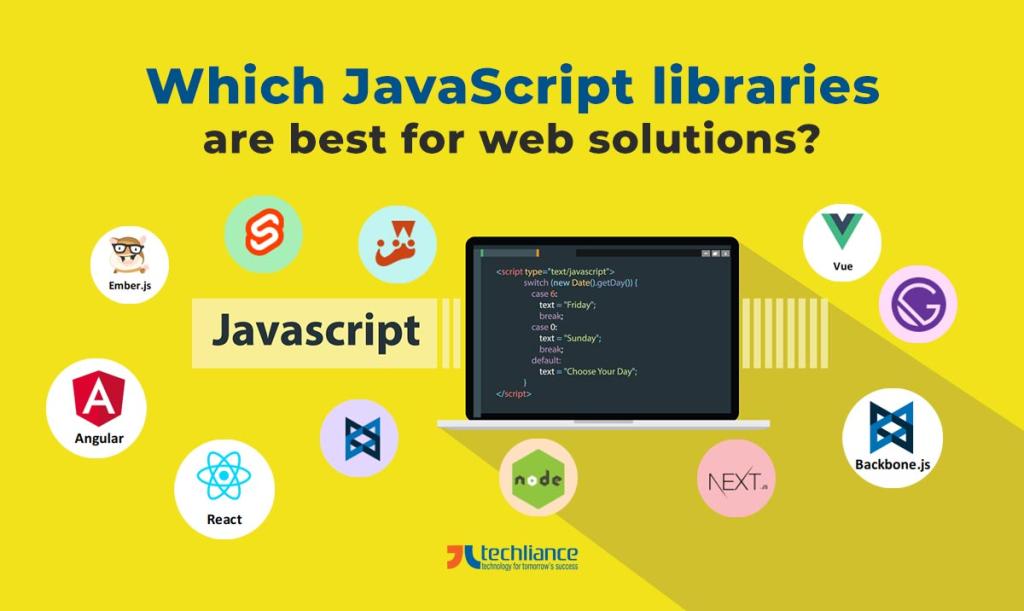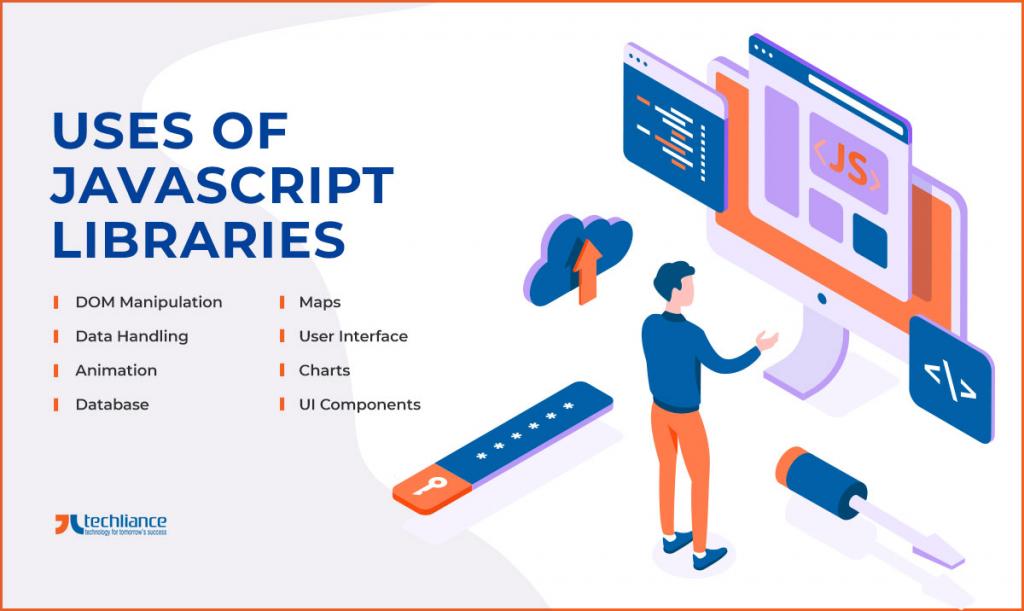In today’s world, every company wants to remain at a hand’s reach to their customers within 2024. Therefore, the consumer market is full of websites that serve the users. Technologies like JavaScript libraries are powering web-driven solutions to enable businesses.
It keeps JavaScript in the limelight — with its existence for over 2 decades. JS continues surprising, charming, and convincing us. Moreover, it has the best JavaScript libraries for boosting performance.
Do you want something? It is just a click away. This is so spontaneous that you don’t have to think twice about it.
Modern technologies help companies to deliver flawless web-centric solutions, that offer perfect online user experience. Nowadays, early to market is a competitive edge, that has no parallel. So, companies prefer efficient technologies, that bring results and have consistent support of the developer community.

What are JavaScript libraries?
JavaScript libraries are collections of pre-written universally accessible JS code files, that reduce development time for websites and web applications. Accordingly, they help businesses in creating quick-to-launch products to better serve the users. Remember that the underlying JavaScript is a front-runner among the leading programming languages of 2024.
JS libraries contain various functions (or lines of code) for performing specific tasks on a web page. So, you can use these built-in JS code libraries to save time and ease your programming workload. Many of the JavaScript libraries are popular globally and in the United States.

How can you use JS libraries?
JS libraries and JavaScript frameworks save you from writing code for every single thing you want to do. The best part is that the libraries have extensive documentation, to help developers use the functions without having any difficulty. Various uses of JavaScript libraries include the following during 2024.
- DOM Manipulation
- Data Handling
- Animation
- Database
- Maps
- User Interface
- Charts
- UI Components
You can utilize JavaScript libraries to develop HTML web pages with dynamic features. For example, navigation, forms, and dynamic content presentation. There are several areas where JS libraries are suitable.
- JavaScript libraries make complex programming tasks easier by allowing programmers to avail building blocks for creating apps.
- They make website development time faster by reducing the amount of code that needs to be downloaded when accessing a page.
- JS libraries can help visualize data in the form of maps and charts. The examples include Google Maps and Google Earth which JS libraries like Chart.js and ApexCharts.js can visualize.
- For effective database management, JavaScript libraries like TaffyDB and ActiveRecord.js let you read, create, delete, edit, and sort data.
- JS libraries such as D3.js can handle and manipulate large amounts of data to make different predictions and forecasts.
- JavaScript libraries such as ImageFX and Refelction.js are great for adding effects and animations to images. The effects include inverting, flipping, contrast, lightening, blurring, sharpening, embossing, grayscaling, etc.
- JS libraries facilitate internet browsing functions like form validation, dynamic content, and animations.

Which are some popular JavaScript libraries?
These are some of the best JS libraries for web-driven solutions in 2024.
- React.js
- jQuery
- Backbone.js
- D3.js
- Underscore.js
Let’s jump into the discussion of narrating the reasons behind their popularity.
React.js
As a scalable and reusable JavaScript library, React.js is suitable for developing intuitive user interfaces (UIs). ReactJS was launched in 2013 by Facebook (now Meta). Gradually, it went on to conquer the market because of its sheer fast speed and response time in web development.
React.js allows incremental usage and has a virtual DOM model for expediting web page content updates. Moreover, it supports the view part of the MVC paradigm. Together with websites and SPAs, React is a top choice for building enterprise applications.
Apart from JavaScript, React supports JSX which provides shorter and simpler syntaxes for common tasks. React also works seamlessly with other JavaScript frameworks like Next.js and others. Likewise, with React Native, developers can create native mobile (Android, iOS) and UWP applications.
ReactJS provides the capability of component development that are fundamentally self-contained modules of code. Even developers can package these modules for reusability. The best part about components is they immensely save time for developers, who can then reuse them across the application.
In case of updating, you have to change the code in one location and it’s updated across the application. So, you don’t have to go back and forth to make the changes everywhere else. React even allows server-side rendering (SSR) which is a much smarter way in comparison to browser rendering.
jQuery
Next in the list is jQuery which is famous for its document object model (DOM) manipulation. Built by John Resig at BarCamp NYC in 2006, jQuery is extremely lightweight and capable of cross-browser functionality. A wide range of techniques enable jQuery to manipulate HTML and CSS.
jQuery is an ideal choice for developers for their web solution development due to a variety of features. It even supports many common event-handling techniques such as key, mouse, focus, and blur functions as well as Ajax calls. One of the plus points of jQuery is that it has a minimalistic API which is extremely easy to use.
With support for AMD modules, both expert programmers and newbie developers prefer jQuery. Its syntax is pretty much similar to CSS, resulting in a higher adoption rate. Lastly, it uses CSS3 selections to manipulate style properties and find elements.
Backbone.js
One of the oldest JS libraries in the market, Backbone.js remains in the game because it is lightweight. Some of the popular websites built on this framework include Twitter, Pinterest, Hulu, and Pandora Radio. BackboneJS is a versatile library that leverages developers to work with a template engine that best suits their requirements.
If you think speed is one of the biggest concerns for your web app, then you should opt for BackboneJS. It’s an ideal choice for simpler projects like SPAs or a widget that is part of a traditional web app. A concern with it is the lack of server-side rendering.
Some developers are not able to cope with the over-simplicity of Backbone.js though. There are a lot of different libraries/frameworks and plug-ins with which BackboneJS mix and match. Nonetheless, it can cause quite a lot of confusion.
D3.js
The next JavaScript library is De3.js which is an abbreviation for data-driven documents. Coming to the forefront in 2011, D3 is famous for the manipulation of documents based on the data. It greatly supports HTML, CSS, and SVG.
Thanks to its data-driven approach, D3.js can easily manipulate the DOM. D3 has a fair comprehensive graphical complexity so that it reduces overheads within the high frame rates. Also, it can even support a vast number of dynamic behaviors and datasets for animations and interactions.
Underscore.js
The final entry in our list is Underscore.js which is a JS utility library for various functions. Built by Jeremy Askenas in 2009, Underscore is the utility-belt library of JS functions. It’s like a native JS library, but it is optimized for JS on the server, and not for the browser.
In comparison to jQuery, Underscore.js is not a complete library. But it has its own practical and standard functions in the jQuery repository or plain JavaScript. It has 100+ functions of 4 different types including array, object, string, math, date, and RegEx to name a few. So, it makes Underscore a functional programming design rather than an object prototype extension.
Advantages of JavaScript libraries
How re-usability of source code can help in quickly crafting quality websites? Are you still not sure, about it? Given below are some major benefits that JavaScript libraries offer through 2024.
- Faster websites
- Knowledge powerhouses
- Getting creative
- Developer community support
- Backable documentation
- Ease of use
- Room for learning
- Great outcome for less budget
- Seamless user experience
Let’s read about the plus points of JS libraries in detail.
Faster websites
It’s not just about having quicker turnaround of websites, but the overall produced code needs to be efficient too. So, that’s what JavaScript libraries offer — efficient code that is fast and boosts the speed of the website. For example, JS libraries like React JS are popular for making fast websites, web apps, and SPAs a reality.

Knowledge powerhouses
The JavaScript libraries are extensive with a wide range of examples to explore. Anything that you want to explore is probably under a specific type of library already. Therefore, you can find out the function you are looking for. Also, they enable newbie developers to learn by going through existing code and seeing how programming is fun.
Getting creative
The JS libraries bring out the creative side of developers. Thus, they allow programmers to see various possibilities of how a certain task can be done. At times, they can even help you brainstorm and build on some ideas, because they have already been done. Hence, you can take a look at the existing function, and then improvise it as per your requirements.
Developer community support
A huge easy-to-reach online developer community backs every JS library. So, it means you don’t have to go through the website-making journey alone. You have a network to communicate, collaborate, and get a fix on a problem — whenever you are stuck on something.
Backable documentation
You get an extensive source of documentation that helps you understand the construct of code. Why spend countless hours coding something that already has a function in a library? Subsequently, you can refer to existing documentation to check out the library functions and you’re good to go.
Ease of use
Most of the functions in JavaScript libraries are easy to use. So, it allows great flexibility in the direction you want to take. You can even customize or enhance the existing code for better performance of your website.
Similarly, it’s fully understandable that the code may have bugs. But debugging the code to identify errors and fixing them shouldn’t take up too much time. If it does, that means debugging is consuming your development time.
It disrupts the development timeline, adding to the developers’ frustration. Additionally, it also causes concerns for the entire project schedule. Pushing back all the deadlines may lead to the project’s ultimate failure.
You don’t want to go there, even in your worst nightmare. The good news is that JavaScript full-stack programming ensures you avoid this situation. Thus, it all results in a great ease of use.
Room for learning
JavaScript libraries provide immense opportunities even for beginner developers. Thanks to JS libraries, they can code and create websites without having to spend countless hours in programming. For instance, many novice programmers like to start with jQuery in their development careers.
Great outcome for less budget
Small-scale businesses and startups don’t need to go overboard with their budget constraints. They may opt against hiring high-potential developers to manage programming expenditures. Because even normal resources can take up the website development project early on.
Seamless user experience
Do you think that website creation is only your headache? What do users care about how you code it? Are they going to see what is behind a website?
That’s where you have it wrong. Users don’t go through your code, but when they visit the website, they experience your entire product in one go. The concept of seamlessness doesn’t mean that users are anxious about how the product works from the backend.
They care about these things. How fast is data retrieval? What is the overall website experience? How do the web pages work?
Therefore, providing higher usability to customers with great user experience makes them engage more on the website. This also increases the chances of converting potential visitors into loyal consumers, and then brand advocates. So, also think in terms of business growth and better ROI.
In the end, it’s about giving users an experience that’s seamless without any hindrances on the website. Henceforth, make the user experience as smooth as possible. Consequently, it becomes more likely they will visit your website again and again.
FAQs about JavaScript libraries
Here are the short answers to frequently asked questions regarding JavaScript libraries.
Can I use a JS library with no knowledge about programming?
JavaScript libraries let you reuse existing code to speed up website development. However, you must know programming to use JS libraries. Learning React.js, Angular, or jQuery is easy for newbies starting their coding journey.
What are the main features of JavaScript libraries?
JS libraries offer a variety of features like these for websites, developers, and users.
- Easy learning curve: JS library is a component with pre-written code. Need we say more? This enables even newbie developers to pick up on the code and get started with it.
- Code reusability: You don’t have to write much code from scratch when you can use a JS library.
- Developer embrace: Newbie developers can learn the code and continue working without any hiccups or halts.
- Community support: JS libraries have tremendous community patronage where developers live by the library code.
- Time reduction: Any change within the library code is then reflected throughout the project wherever it is referenced.
- Save money: The reusable components are greatly handy for saving money. Less development time frame means less project cost.
What was the first JavaScript library?
Prototype.js (2005), Dojo Toolkit (2005), jQuery (2006), MooTools (2006), Base2 (2007), and Ext JS (2007) are the earliest JavaScript libraries. YUI library by Yahoo! is also an earlier JS library (but it is not under active support after 2014). Among these, jQuery is the only JavaScript library that is in mainstream use.

Conclusion
We have put some effort into elaborating on the potential usefulness of JavaScript libraries. It is important to realize that having built-in functional code accelerates the development time. So, this makes it easier for companies to launch products in the market with less turnaround time.
This supports companies to spend less budget on developing viable products. Likewise, these solutions are holistic and have a rich user experience. As a result, companies of varied magnitude can build websites that reflect their capabilities.
It gives them a chance to showcase their products in the consumer market. To sum it up, JavaScript libraries play a vital role in creating multi-faceted websites. The ones that speak to the target audience on various levels.
Are you looking for a well-executed website or SPA? Connect with Techliance today for a discussion on how we can help you deliver what you require. After all, together we can do wonders with a user-inticing web app.
About the author




